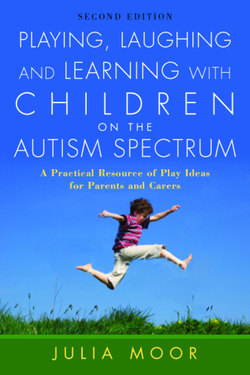Читать книгу Playing, Laughing and Learning with Children on the Autism Spectrum - Julia Moor - Страница 16
На сайте Литреса книга снята с продажи.
What is Intensive Interaction?
ОглавлениеIntensive Interaction is a teaching method of exploring and using the very fundamentals of communication with children and adults who have severe communication challenges. During the first year of a typically developing baby’s life, a highly complex but very natural series of social responses and communicative exchanges happens between the baby and the adults around him. Intuitively, parents follow their baby’s cues to respond, they put the child in control of the type of engagement and the duration, it may be blowing raspberries, imitating vocalizations or pulling faces. Invariably these early interactions involve eye contact, sound making and turn-taking and lots of repetition – the building blocks of early language. We can learn a lot about communication by looking at these natural processes, breaking down exactly what happens and working through the stages with older children whose autism has interfered with this natural and vital early development.
As a teaching approach for nonverbal hard to reach children, Intensive Interaction builds on these principles of following the child’s lead in interactive rather than directive play. For children beyond baby years this type of playing can seem uncomfortable for parents to engage in at first. We are employing strategies that we inevitably used the first time round when our children were indeed babies. So why revisit this stage of development? There will be parents reading this book desperately hoping for ideas to connect with a child so withdrawn into autistic aloneness that activities such as structured learning and language building are out of reach – your child needs to connect with you first, even fleetingly. The natural processes of early communication have been altered by autism, but that is not to say that they have been damaged for good. By extending and intensifying the period of early pre-verbal parent/child interaction you are giving your child’s brain more time to respond – your child may be developmentally delayed so playing at this very early parent/baby level with your older child will be appropriate and right for him. Ultimately if Intensive Interaction has significant results with adults on the severe end of the autism spectrum (and it does), then a child can benefit even more from the ‘neural plasticity’ that young brains have.
The goal is to create some sense of meaning and enjoyment in just being with others, to ‘re-wire’ the processes that drive a child to resist and avoid relatedness at all costs by engaging in an activity that is intrinsically motivating and rewarding – this is the first and most important aim. Enjoyment comes from your child being calm and sharing control, feeling safe and having fun in the most basic form of interaction. This is sharing space at foundation level: enjoying being with another person. Intensive Interaction is not an overnight autism cure, it is one of many intervention strategies which with lots of effort, perseverance and repetition can increase your child’s motivation to relate.
You may wish to explore Intensive Interaction further, to attend training or watch it in process. For information, newsletters and training information, visit: www.intensiveinteraction.co.uk
